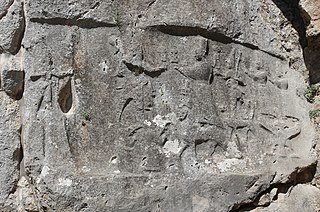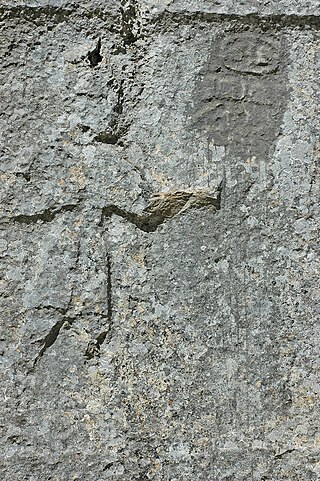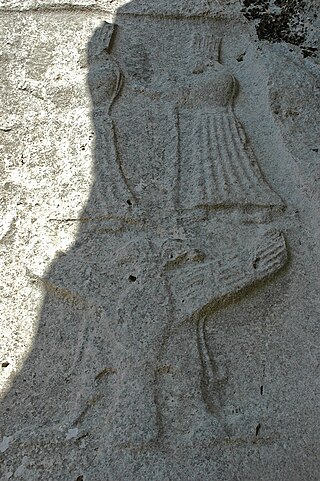Related Research Articles

In Mesopotamian mythology, Ereshkigal was the goddess of Kur, the land of the dead or underworld in Sumerian mythology. In later myths, she was said to rule Irkalla alongside her husband Nergal. Sometimes her name is given as Irkalla, similar to the way the name Hades was used in Greek mythology for both the underworld and its ruler, and sometimes it is given as Ninkigal, lit. "Lady of the Great Earth".

Teshub was the Hurrian weather god, as well as the head of the Hurrian pantheon. The etymology of his name is uncertain, though it is agreed it can be classified as linguistically Hurrian. Both phonetic and logographic writings are attested. As a deity associated with the weather, Teshub could be portrayed both as destructive and protective. Individual weather phenomena, including winds, lightning, thunder and rain, could be described as his weapons. He was also believed to enable the growth of vegetation and create rivers and springs. His high position in Hurrian religion reflected the widespread importance of weather gods in northern Mesopotamia and nearby areas, where in contrast with the south agriculture relied primarily on rainfall rather than irrigation. It was believed that his authority extended to both mortal and other gods, both on earth and in heaven. However, the sea and the underworld were not under his control. Depictions of Teshub are rare, though it is agreed he was typically portrayed as an armed, bearded figure, sometimes holding a bundle of lightning. One such example is known from Yazılıkaya. In some cases, he was depicted driving in a chariot drawn by two sacred bulls.

Ḫepat was a goddess associated with Aleppo, originally worshiped in the north of modern Syria in the third millennium BCE. Her name is often presumed to be either a feminine nisba referring to her connection to this city, or alternatively a derivative of the root ḫbb, "to love". Her best attested role is that of the spouse of various weather gods. She was already associated with Adad in Ebla and Aleppo in the third millennium BCE, and in later times they are attested as a couple in cities such as Alalakh and Emar. In Hurrian religion she instead came to be linked with Teshub, which in the first millennium BCE led to the development of a tradition in which she was the spouse of his Luwian counterpart Tarḫunz. Associations between her and numerous other deities are described in Hurrian ritual texts, where she heads her own kaluti, a type of offering lists dedicated to the circle of a specific deity. She commonly appears in them alongside her children, Šarruma, Allanzu and Kunzišalli. Her divine attendant was the goddess Takitu. In Hittite sources, she could sometimes be recognized as the counterpart of the Sun goddess of Arinna, though their respective roles were distinct and most likely this theological conception only had limited recognition. In Ugarit the local goddess Pidray could be considered analogous to her instead.

Pinikir, also known as Pinigir, Pirengir, Pirinkir, and Parakaras, was an Ancient Near Eastern astral goddess who originates in Elamite religious beliefs. While she is only infrequently attested in Elamite documents, she achieved a degree of prominence in Hurrian religion. Due to her presence in pantheons of many parts of the Ancient Near East, from Anatolia to Iran, modern researchers refer to her as a "cosmopolitan deity."
Kamrušepa was a Hittite and Luwian goddess of medicine and magic, analogous to Hattic and Palaic goddess Kataḫzipuri. She is best known as one of the deities involved in the Telepinu Myth, in which her actions were crucial to pacify the anger of the "missing" vegetation god.

Ishara (Išḫara) was a goddess originally worshipped in Ebla and other nearby settlements in the north of modern Syria in the third millennium BCE. The origin of her name is disputed, and due to lack of evidence supporting Hurrian or Semitic etymologies it is sometimes assumed it might have originated in a linguistic substrate. In Ebla, she was considered the tutelary goddess of the royal family. An association between her and the city is preserved in a number of later sources from other sites as well. She was also associated with love, and in that role is attested further east in Mesopotamia as well. Multiple sources consider her the goddess of the institution of marriage, though she could be connected to erotic love as well, as evidenced by incantations. She was also linked to oaths and divination. She was associated with reptiles, especially mythical bašmu and ḫulmiẓẓu, and later on with scorpions as well, though it is not certain how this connection initially developed. In Mesopotamian art from the Kassite and Middle Babylonian periods she was only ever represented through her scorpion symbol rather than in anthropomorphic form. She was usually considered to be an unmarried and childless goddess, and she was associated with various deities in different time periods and locations. In Ebla, the middle Euphrates area and Mesopotamia she was closely connected with Ishtar due to their similar character, though they were not necessarily regarded as identical. In the Ur III period, Mesopotamians associated her with Dagan due to both of them being imported to Ur from the west. She was also linked to Ninkarrak. In Hurrian tradition she developed an association with Allani.

Nikkal or Nikkal-wa-Ib was a goddess worshiped in various areas of the ancient Near East west of Mesopotamia. She was derived from the Mesopotamian goddess Ningal, and like her forerunner was regarded as the spouse of a moon god, whose precise identity varied between locations. While well attested in Hurrian and Hittite sources, as well as in Ugarit, she is largely absent from documents from the western part of ancient Syria.

Šauška (Shaushka), also called Šauša or Šawuška, was the highest ranked goddess in the Hurrian pantheon. She was associated with love and war, as well as with incantations and by extension with healing. While she was usually referred to as a goddess and with feminine titles, such as allai, references to masculine Šauška are also known. The Hurrians associated her with Nineveh, but she was also worshiped in many other centers associated with this culture, from Anatolian cities in Kizzuwatna, through Alalakh and Ugarit in Syria, to Nuzi and Ulamme in northeastern Mesopotamia. She was also worshiped in southern Mesopotamia, where she was introduced alongside a number of other foreign deities in the Ur III period. In this area, she came to be associated with Ishtar. At a later point in time, growing Hurrian influence on Hittite culture resulted in the adoption of Šauška into the Hittite state pantheon.

Allani, also known under the Akkadian name Allatu, was the Hurrian goddess of the underworld. She was also associated with the determination of fate. She was closely linked with Ishara, and they could be invoked or receive offerings together. She also developed connection with other underworld deities from neighboring cultures, such as Mesopotamian Ereshkigal, Anatolian Sun goddess of the Earth and Lelwani, and possibly Ugaritic Arsay. It is presumed she was chiefly worshiped in western areas inhabited by the Hurrians, though the location of her main cult center is uncertain. She is attested in texts from sites such as Tigunani, Tuttul and Ugarit. She was also incorporated into the Mesopotamian pantheon, and was venerated in Ur, Nippur and Sippar. Hittite sources mentioning her are known too.

The Hurrian religion was the polytheistic religion of the Hurrians, a Bronze Age people of the Near East who chiefly inhabited the north of the Fertile Crescent. While the oldest evidence goes back to the third millennium BCE, it is best attested in cuneiform sources from the second millennium BCE written not only in the Hurrian language, but also Akkadian, Hittite and Ugaritic. It was shaped by the contacts between Hurrians and various cultures they coexisted with. As a result, the Hurrian pantheon included both natively Hurrian deities and those of foreign origin, adopted from Mesopotamian, Syrian, Anatolian and Elamite beliefs. The culture of the Hurrians was not entirely homogeneous, and different local religious traditions are documented in sources from Hurrian kingdoms such as Arrapha, Kizzuwatna and Mitanni, as well as from cities with sizeable Hurrian populations, such as Ugarit and Alalakh.

Nupatik, in early sources known as Lubadag, was a Hurrian god of uncertain character. He is attested in the earliest inscriptions from Urkesh, as well as in texts from other Hurrian settlements and Ugarit. He was also incorporated into Hittite religion. A similarly named deity continued to be venerated in Arbela as late as in the Neo-Assyrian period.
Shuwala (Šuwala) was a Hurrian goddess who was regarded as the tutelary deity of Mardaman, a Hurrian city in the north of modern Iraq. She was also worshiped in other Hurrian centers, such as Nuzi and Alalakh, as well as in Ur in Mesopotamia, Hattusa in the Hittite Empire and in the Syrian cities Emar and Ugarit.

Nabarbi or Nawarni was a Hurrian goddess possibly associated with pastures. She was one of the major deities in Hurrian religion, and was chiefly worshiped in the proximity of the river Khabur, especially in Taite. It has been proposed that she was associated with the goddess Belet Nagar, linked to the Upper Mesopotamian city of Nagar. In addition to being venerated in Hurrian religion, she was also incorporated into the beliefs of the Hittites and into the local pantheon of Emar. She also continued to be worshiped in Taite in the Neo-Assyrian period, as attested in a text from the reign of Ashurbanipal, where she is one of the deities invoked to bless the king.
Tašmišu (Tashmishu) was a Hurrian god. He was regarded as a brother of Teshub, and it is assumed he had a warlike character.
Alla or Alla-gula was a Mesopotamian god associated with the underworld. He functioned as the sukkal of Ningishzida, and most likely was a dying god similar to Dumuzi and Damu, but his character is not well known otherwise. He had his own cult center, Esagi, but its location is presently unknown.

Allanzu, later known under the name Alasuwa, was a Hurrian goddess regarded as a daughter of Ḫepat. She was described as a youthful deity and in known texts often appears in association with her mother and siblings. She was also worshiped by Hittites and Luwians.
Šulinkatte was a Hittite god of Hattian origin. He was regarded as a war deity. Additionally, he could fulfill the role of a protector of palaces and houses. In the local tradition of Nerik, he was regarded as the father of the weather god of Nerik. He first appears in texts dated to the fifteenth or fourteenth century BCE. His main cult center was the sparsely attested city Tamarmara, but he was also worshiped elsewhere in ancient Anatolia, for example in Hattusa and Nerik. Fragments of a Hattic song celebrating him are also known.
Uršui or Uršue was a Hurrian goddess. Her name might be derived from the toponym Uršu. It is not certain if the also attested name Uršui-Iškalli should be interpreted as Uršui's name being used as an epithet, as her name accompanied by epithet, or as a pair of goddesses. In Hurrian offering lists, appears as a member of the circle of either Ḫepat or Šauška.

Hurrian primeval deities were regarded as an early generation of gods in Hurrian mythology. A variety of Hurrian, Hittite and Akkadian labels could be used to refer to them. They were believed to inhabit the underworld, where they were seemingly confined by Teshub. Individual texts contain a variety of different listings of primeval deities, with as many as thirty names known, though many are very sparasely attested. Some among them were received from Mesopotamia, but others might have names originating in Hurrian or a linguistic substrate. No specific cult centers of the primeval deities have been identified, and they were not worshiped by all Hurrian communities. They were also incorporated into Hittite religion, presumably either from Kizzuwatna or Syria. Offers were made to them in sacrificial pits, examples of which have been identified in Urkesh and Hattusa. The primeval deities also appear in a number of Hurrian myths, including multiple sections of the Kumarbi Cycle and the Song of Release.
References
- ↑ Schuler 1983, p. 595.
- 1 2 Taracha 2009, p. 124.
- 1 2 Archi 2013, p. 3.
- 1 2 Wilhelm 2014, p. 345.
- ↑ Archi 2013, p. 17.
- 1 2 Schuler 1983, p. 596.
- 1 2 3 4 5 Archi 2013, p. 4.
- ↑ Archi 2013, pp. 16–17.
- ↑ Schuler 1983, pp. 596–597.
- ↑ Taracha 2009, pp. 124–125.
- 1 2 Archi 2013, p. 2.
- ↑ Archi 2013, pp. 2–3.
- ↑ Wilhelm 2014, p. 346.
Bibliography
- Archi, Alfonso (2013). "The Anatolian Fate-Goddesses and their Different Traditions". Diversity and Standardization. De Gruyter. doi:10.1524/9783050057576.1.
- Schuler, Einar von (1983), "Lelwani", Reallexikon der Assyriologie (in German), retrieved 2022-03-18
- Taracha, Piotr (2009). Religions of Second Millennium Anatolia. Harrassowitz. ISBN 978-3447058858.
- Wilhelm, Gernot (2014), "Unterwelt, Unterweltsgottheiten C. In Anatolien", Reallexikon der Assyriologie (in German), retrieved 2022-03-18